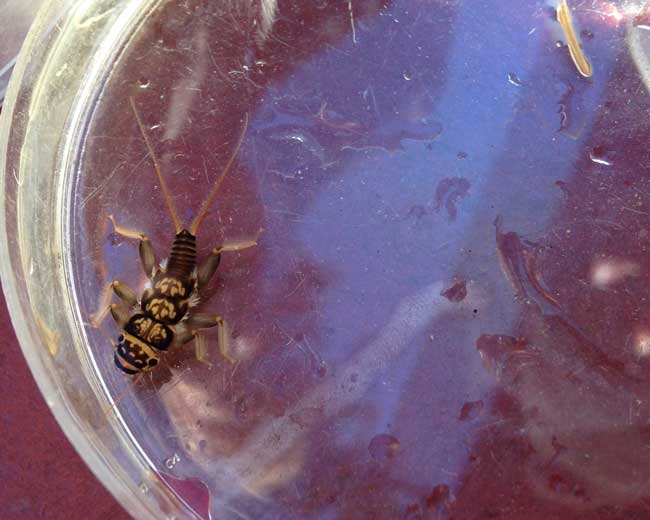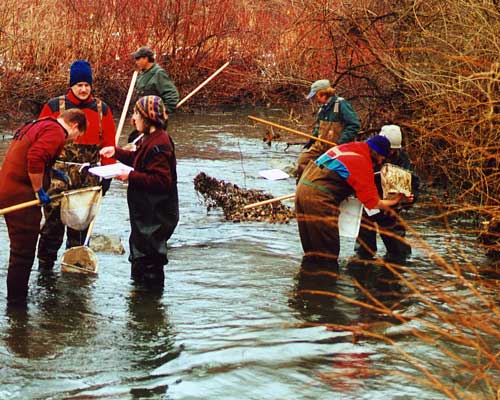HRWC is celebrating 30 years of River Roundups, our macroinvertebrate monitoring program! In 1992, a group of pioneering staff and volunteers first stuck their nets into flowing water and dumped debris into white pans, searching for benthic macroinvertebrates. This established a legacy of volunteer science that has since spread across Michigan, engaged thousands of people, and greatly expanded our knowledge of the Huron River watershed. You can read all about the history of HRWC macroinvertebrate monitoring in Thirty Years of Bugs and Citizen Science, Part 1.
The Data

With 30 years of monitoring comes 30 years of data. River Roundups and Stonefly Searches are great educational events, but they serve a dual purpose in also providing HRWC with knowledge about the ecological quality of the watershed’s aquatic systems. Insects living in streams compose the benthic macroinvertebrate population, along with clams and other mollusks, crayfish, and other taxa. Typically, monitoring focuses on insects (in aquatic stages of development) as they are representative of a variety of feeding levels in the ecosystems’ food webs, are sensitive to local environmental conditions, and are easy to collect. Since the macroinvertebrate population depends on the physical conditions of the stream as well as water quality, its composition indicates overall stream quality. Insect diversity indicates good stream quality and is measured by the number of different insect families. Eighty-seven benthic insect families are found in the Huron River watershed (although we never find them at the same place all at once!).
Data analysis
After the River Roundups and ID Days, HRWC staff examine the numbers and types of macroinvertebrates found. We consider total abundance and diversity metrics such as number of different insect families found at each site (“families” are groups of species that share similar characteristics and evolutionary history). We analyze whether these numbers change from year to year. This information tells us how healthy the stream is, and if it is improving, declining, or staying the same.
On average, moderately healthy streams in the Huron River watershed have around 11 aquatic insect families, 3-4 crustacean families (typically crayfish, scuds, and sowbugs), and several families of clams and mussels (HRWC does not identify clams and mussels, though we are looking into creating a citizen science mussel survey). The best streams in the watershed have up to 23 aquatic insect families; the most degraded have about 4 insect families. Volunteers usually collect between 75 and 150 specimens in an hour’s work in average-to-healthy streams but will struggle to find 30 specimens in an hour at the most degraded locations.

The most alarming, yet useful, finding is when we discover that a good site is in the process of declining; these are the sites to which we need to pay the most attention. We tell state biologists about these sites and ask them to check out the locations themselves. They are often the streams on which we plan extra monitoring or restoration projects. Another useful finding is when we see a degraded stream getting better; these are success stories not just for HRWC but also the larger watershed community.
Guiding practices and results
River Roundup data has guided much HRWC work and provides proof of success for multiple projects:
- After a 2016 data analysis of macroinvertebrate and land use data showed Norton Creek as a highly degraded stream, HRWC received a grant that funded
more in-depth monitoring, which indicated that the creek suffered from low dissolved oxygen levels. HRWC worked with engineers to anchor tree and shrub branches to the banks to create a more natural, curvy stream flow that narrowed the stream channel to scour fine sediment and churn the water. We also installed rain gardens in Wixom to reduce polluted runoff entering the creek directly. - Malletts Creek is an urban creek with a very poor macroinvertebrate community. After many projects, including bank stabilization on the lower sections and stormwater detention at Mary Beth Doyle Park, HRWC has measured statistically significant increases in both macroinvertebrate abundance and diversity. The creek used to hold about 5 insect families but now has closer to 9; the higher diversity reflects a broader range of suitable habitat (pools, riffles, undercut banks) and better water quality than this site displayed prior to restoration efforts.
- In 2008, the City of Dexter and HRWC removed the dam that blocked Mill Creek from the Huron River, sparking a renaissance of waterfront parkland for the City of Dexter. Removing the dam cooled the creek’s water temperature, started a long process of scouring the stream reach of sediment, and created more diverse habitat structure in which macroinvertebrates (and fish!) now live. Since dam removal, the number of highly sensitive insects—those that can only live in the highest quality areas—has nearly tripled from an average of 1.5 sensitive insect families to 4 sensitive insect families found per River Roundup event.
- Sometimes, the most important thing the River Roundup provides is not the data but getting eyes directly on the water where people don’t normally look. In the early 2000s, volunteers sampling on Letts Creek in Chelsea found a stream with drastically reduced insect abundance, fine sediment that billowed up with a greasy smell when the volunteers waded in it, and occasional oily sheens on the surface. HRWC was able to track the sheen upriver and discovered a local business that was allowing rainwater to fill up barrels of greasy machine parts and overflow to the creek. HRWC contacted the state authorities and the polluter was stopped.
The work continues!
Macroinvertebrate monitoring allows HRWC to keep its finger on the pulse of the watershed. The data can be messy and variable, but after years of monitoring any particular place the data can demonstrate distinct, usable patterns that are crucial to our understanding of water quality throughout the watershed. Importantly, none of this work would be possible without the support of the HRWC community of volunteers and friends; you are committed individuals who all believe in our mission. Thank you so much. We can never say it enough!
The monitoring is an ongoing effort, always in need of more people to join the community! So c’mon out with your friends and family.
Our next monitoring event will be our Winter Stonefly Search in January 2023.
This blog post was originally published in the Huron River Report, Fall 2022.



